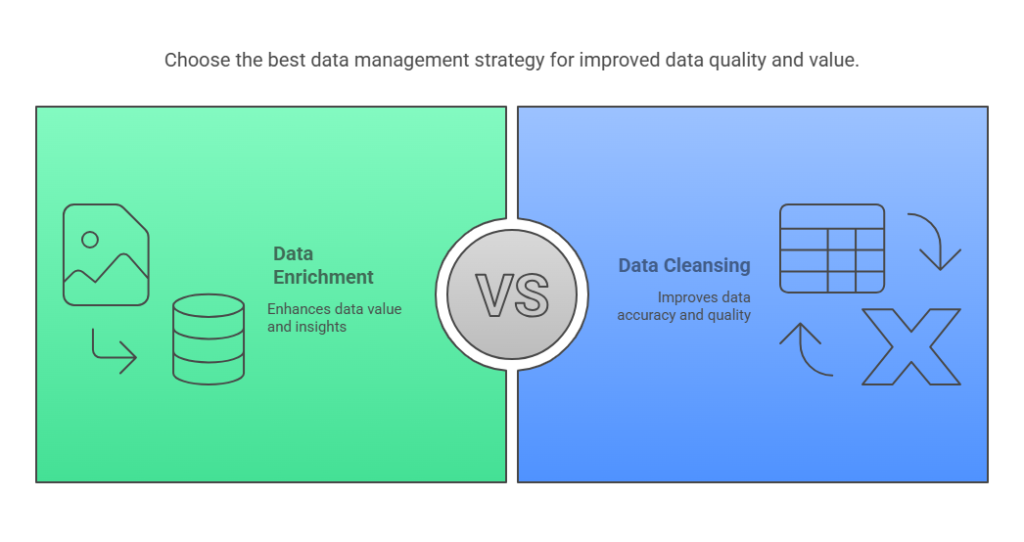
Your business data is the engine that powers marketing, sales, and automation.
But when that data is full of errors or missing context, even the best strategies fall apart.
That’s where data cleansing and data enrichment come in.
Both improve data quality — one by fixing information, the other by adding valuable insights.
Together, they turn raw contacts into real opportunities.
This guide breaks down what each means, how they differ, and how combining them leads to smarter, more profitable decisions.
What Is Data Cleansing?
Data cleansing (or data cleaning) is the process of removing incorrect, incomplete, or duplicate records from your database.
It’s about ensuring every field — email, name, phone number, company, job title — is accurate and standardized.
Think of cleansing as the “quality control” step of your CRM.
Common Data Cleansing Tasks
- Deleting duplicate or outdated entries
- Correcting spelling or formatting errors
- Standardizing company names or job titles
- Removing bounced or invalid email addresses
- Fixing inconsistent capitalization or special characters
Clean data improves deliverability, lead scoring, and analytics accuracy.
That’s why every Lead Generation Audit should start with cleansing before any enrichment or automation.
What Is Data Enrichment?
Once your data is clean, it’s time to make it smarter.
Data enrichment means adding missing or complementary details to existing records using verified external or first-party sources.
For instance, you might take a lead with only an email address and enrich it with:
- Company name, size, industry, and revenue
- Contact’s role and seniority level
- LinkedIn URL or business domain
- Social media profiles (for B2C)
- Purchase intent or behavioral signals
Enrichment helps you understand who your prospects really are and what they’re likely to do next.
It gives your marketing a sharper focus and your sales team better context.
Explore verified B2B Data Services or E-Commerce Data Solutions to start enriching your existing database at scale.
Data Enrichment vs Data Cleansing: What’s the Difference?
Here’s the simplest way to put it:
- Cleansing makes your data accurate.
- Enrichment makes your data intelligent.
| Aspect | Data Cleansing | Data Enrichment |
|---|---|---|
| Purpose | Correct and remove bad data | Add new, valuable details |
| Focus | Accuracy and consistency | Depth and context |
| When to Use | Before campaigns or automation | After cleaning for deeper insights |
| Source Type | Internal or first-party data | Verified external databases |
| Outcome | Reliable, usable dataset | Enriched profiles with actionable insights |
Both processes work hand-in-hand: you clean first, then enrich to maximize precision and value.
Why Both Are Critical for Growth
Using only one process limits your potential. Cleansing alone makes data usable; enrichment makes it powerful.
Benefits of Combining Both
- Higher email deliverability and campaign performance
- Improved segmentation and personalization
- Better lead scoring and prioritization
- Increased CRM adoption and reporting accuracy
- Stronger data compliance and governance
If your business relies on outbound lead generation, LinkedIn outreach, or ABM, you need both processes in sync.
Our B2B SaaS Lead Generation Guide explains how data quality directly impacts sales velocity.
Best Practices for Data Quality Management
Maintaining clean and enriched data is not a one-time project — it’s an ongoing discipline.
Here’s how to keep your database in peak condition:
- Clean first, enrich second.
Don’t append data to dirty records — fix them first. - Automate updates.
Use enrichment APIs to refresh records in real time. - Validate sources.
Work only with GDPR-compliant providers like LFBBd’s B2B Database to ensure accuracy. - Set a refresh schedule.
Re-enrich your data quarterly to prevent decay. - Track ROI.
Use the B2B ROI Calculator to measure revenue impact.
Following these practices builds a database that performs — not just stores.
How to Combine Cleansing and Enrichment (The Ideal Workflow)
To get the best results, run these two processes in sequence:
- Audit your existing data – identify duplicates, missing fields, and inconsistencies.
- Cleanse the dataset – correct or remove invalid entries.
- Enrich with external data – add new firmographic or behavioral insights.
- Validate and monitor – regularly check for errors, changes, and decay.
This “Clean → Enrich → Validate” cycle ensures your CRM stays accurate and high-value year-round.
Common Mistakes to Avoid
Avoid these pitfalls that waste data budgets and lower ROI:
- Mixing cleansing and enrichment into one step
- Buying cheap, scraped, or non-compliant data
- Ignoring privacy and consent requirements
- Enriching stale or duplicate data
- Skipping quarterly revalidation
Data is like food — it expires. Clean it often and enrich it wisely.
Tools and Platforms to Support Each Process
| Use Case | Recommended Tools | Key Advantage |
|---|---|---|
| Data Cleansing | HubSpot, OpenRefine, Dedupely | Automates cleanup and standardization |
| Data Enrichment | Apollo.io, Clearbit, ZoomInfo | Adds verified business intelligence |
| Hybrid Workflow | LFBBd B2B Database | Combines cleansing, validation, and enrichment |
Each serves a unique purpose — but for verified, ready-to-use business data, our B2B Data Services offer the best of both worlds.
Frequently Asked Questions
1. What’s the difference between data enrichment and data cleansing?
Cleansing fixes errors and removes bad records; enrichment adds new, valuable information to enhance context.
2. Which should I do first?
Always cleanse first — otherwise you’ll enrich inaccurate or duplicate data.
3. How often should I clean or enrich my database?
Quarterly is best for most businesses, or after major list imports.
4. Can enrichment introduce errors?
Only if you use unreliable data vendors. Always choose verified sources like LFBBd.
5. What’s the ROI of enrichment?
Businesses typically see a 15–30% lift in conversion rates after combining cleansing with enrichment.
Conclusion
Clean data prevents mistakes; enriched data drives growth. When you combine both, you create a marketing and sales system that scales efficiently, adapts quickly, and stays compliant.

